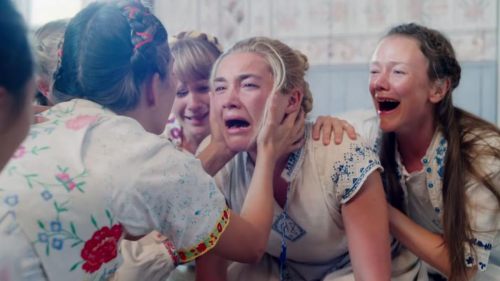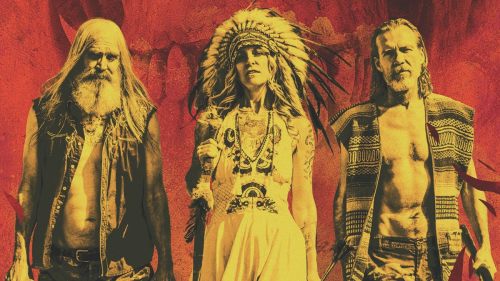Director Duncan Skiles Talks THE CLOVEHITCH KILLER And Making The Mundane Mortifying
The Clovehitch Killer is a creepy little gem that could end up flying under the radar if you're not careful. I had the joy of seeing the thriller back in September, where I liked it quite a bit, saying:
"...what makes [director] Duncan Skiles' slow burn horror movie a familiar but engrossing experience is the fact that the central mystery often takes a backseat – at least during the film's pensive and unsettling first half – to watching Tyler (Charlie Plummer) continue to try and maintain a normal relationship with his father (Dylan McDermott), despite discovering a stack of bondage porn and bloody photos in his pop's private shed..."
I had the treat of sitting down with director Duncan Skiles shortly after, to talk about this nasty coming of age chiller. What followed was a breezy chat regarding the filmmaker's idiosyncratic, sepia-toned approach to telling this unsettling tale...
*****
Birth.Movies.Death: I guess my first question is - how did you come to want to make this movie about a family man who's also a serial killer in the American Heartland?
Duncan Skiles: I was doing a lot of research on serial killers, and I came across the idea that some of them had families when they were caught, and I thought it would be interesting to tell a story that was from the perspective of that family. Because I wanted to make a movie that was in that world, but I didn't really want to make the serial killer the main character. I don't really like [serial killers] as characters, you know, so I wanted to make something that was about a serial killer, but that was also kind of wholesome and relatable.
BMD: You definitely tossed in an undercurrent almost like - and I know this is kind of a basic comparison - but it reminded me a lot of watching John Carpenter's Halloween for the first time, in that it explores how evil can infect the places that we consider the safest.
DS: I call it "normcore". My goal was to set everything in a very normal, relatable environment with minimal "traditional" horror cues. So, everything's happening in the daytime and there's not a lot of music. I wanted simple angles that felt safe. Because I remember the feeling that I got when I was doing this research, about how horrible things can be injected into normalcy, and that was frightening. I kind of wanted to capture that feeling.
BMD: It's sort of fascinating how you cast Dylan McDermott because, let's face it, he's not "normal" looking. For a certain generation, he's a pretty iconic TV actor. I wondered how the two of you approached helping him fit into this realm of "normalcy" and become this Father Knows Best archetype?
DS: I had reservations about casting Dylan for that reason, because I did want the dad to be very "dad like", and Dylan was very enthusiastic about it. He sent in an audition video and was able to physically change himself, even just in the audition. He had this hair and was wearing glasses and put on an accent. We knew this would be sort of a difficult role to cast because of the depths of darkness that the character goes through. It's kind of hard to find a leading man who's willing to do that. And Dylan was really excited to do it.
So, I started to think that maybe it'd be cool to have some kind of "transformational" role. I've always thought those kinds of roles are cool. Like, not realizing it's Charlize Theron until you're 20 minutes into Monster. I thought we could try to do something like that with Dylan, and we sort of shaved his hairline back, and dyed his temples gray, and he wore a prosthetic belly. Dylan just embraced it, right down to the Boy Scout leader outfits. He brought the accent to it, and the posture, and he was in character the whole time. So, we called him "Don" on set, and "Dylan" was just gone the entire time. He was that guy, which was creepy.
BMD: The community in Kentucky where they live - I'm very curious to hear you talk about it. There's almost a religious aspect to the movie. I don't want to say that this is a "fundamentalist" community, but it's a very repressed one. Can you talk about the way religion and repression become cornerstones of this idyllic Kentucky neighborhood?
DS: Well, I come from Northwest Arkansas and it's a Bible Belt region. My experience growing up is that I was sort of around a lot of churches and religious people. I didn't want it to be a caricature of those places or people. We worked with the people in the church where we shot. I just wanted to make something that was as realistic as possible, but also outside the realm of my current experience. I've spent a lot of time in New York now, and we sort of underestimate the true religious nature of the middle of the [United States]. I wanted to represent that, but I never intended it to be a statement on that.
BMD: And I don't think it comes off as a "statement", per se. But you definitely understand how ingrained religion is in the fabric of these people's lives, and how that may suppress certain, uh, appetites...
Now, how did you approach this wholesome tone with Charlie Plummer? What was your main goal building that character with him? Because we see almost everything through his eyes.
DS: Well, it's funny. My intention was to have him be this rosy-cheeked Boy Scout in the beginning and go through this transformation, almost like the death of a Hardy Boy. It was this really innocent person confronting something really dark. Charlie was on board with that through the auditions and stuff. But then he did this movie just before ours (Lean On Pete) that kinda put him through the emotional ringer. He arrived on set, and had changed from the Charlie that I knew from the auditions. But I think it worked out, because he felt like this very natural teenager. That's what I really appreciated about Charlie: he's doesn't do anything if it doesn't feel natural, so I had to push him a little bit in order to get him a little more chipper in the beginning. But unless it was coming from a real place, he wasn't into doing it.
BMD: I'm trying to avoid spoiling anything for the audience, but how did you approach the tonal shift in the film? It's almost cleanly split into two halves, with the second being a more straight-ahead horror picture.
DS: Well, I wanted to take people by surprise a little bit, but gradually instead of a "clean split". I wanted to make the audience feel like they had been abandoned somewhat; like they thought they were watching one type of movie and then realize that they're watching a different type of movie. But it's tough for them to emotionally prepare themselves because that's how I felt when I was reading the stories of people just going about their day and there's a knock on the door, and there's a stranger who wants to check the utility lines, and then suddenly they're being tied up and killed. So, again, I wanted to capture the realness of how normalcy can be interrupted by these horrible events. It's terrifying.
The Clovehitch Killer is available now in select theaters and on VOD.



